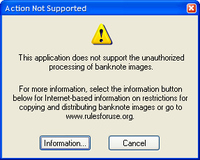It may not look like a Greek hunter, but a small pattern of symbols found on some banknotes named after one of the universe’s most prominent constellations does its best to battle counterfeiters.
The EURion constellation is a pattern made up of five rings that are added to banknotes in order to prevent counterfeiters from creating forgeries using colour photocopies. Though the pattern has been used on banknotes around the world for nearly 15 years, the name was coined in early 2002 by a German computer scientist named Markus Kuhn who uncovered the pattern while experimenting with a Xerox colour photocopier that refused to reproduce banknotes.
Combing the words “Orion” and “Euro,” the EURion constellation can be found at various locations on banknotes – depending on the design – and is used on currency across the globe.
Many banks and banknote producers integrate the EURion constellation into the design of bill in order to mask its presence. On a 1000 rupees (2000) Indian banknote, for example, the EURion constellation forms tiny circles in a background near watermark and above Gandhi image head.
The technical details of the EURion constellation are highly secretive. Some have speculated that the integer ratios between the squared distances of nearby circles are what cause software to recognize that the banknote is trying to be copied. Much like the software employed by the Central Bank Counterfeit Deterrence Group, the EURion constellation tips off the copying device and prevents forgeries.
Some scientists, however, have hypothesized that the EURion constellation isn’t the device triggering the software. Steven Murdoch, a security researcher at the University of Cambridge Computer Laboratory, has said he believes the trigger is instead a digital watermark embedded in the notes.
Currently, over 40 countries use the EURion constellation on their banknotes including the United States, Canada, Turkey, Sweden, India, Norway, and Australia
 Recent versions of image editors such as Adobe Photoshop or Paint Shop Pro refuse to print banknotes. According to Wired.com, the banknote detection code in these applications, called the Counterfeit Deterrence System (CDS), was designed by the Central Bank Counterfeit Deterrence Group and supplied to companies such as Adobe as a binary module.
However, experiments by Steven J. Murdoch and others showed that this
banknote detection code does not rely on the EURion pattern. It instead detects a digital watermark embedded in the images, developed by Digimarc.
Recent versions of image editors such as Adobe Photoshop or Paint Shop Pro refuse to print banknotes. According to Wired.com, the banknote detection code in these applications, called the Counterfeit Deterrence System (CDS), was designed by the Central Bank Counterfeit Deterrence Group and supplied to companies such as Adobe as a binary module.
However, experiments by Steven J. Murdoch and others showed that this
banknote detection code does not rely on the EURion pattern. It instead detects a digital watermark embedded in the images, developed by Digimarc. 
No comments:
Post a Comment